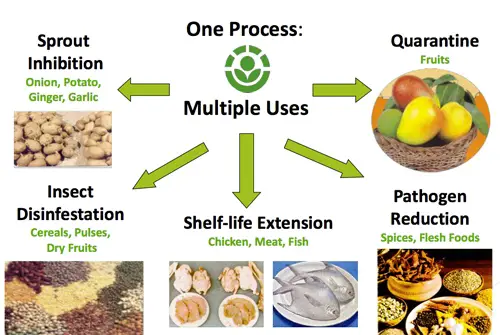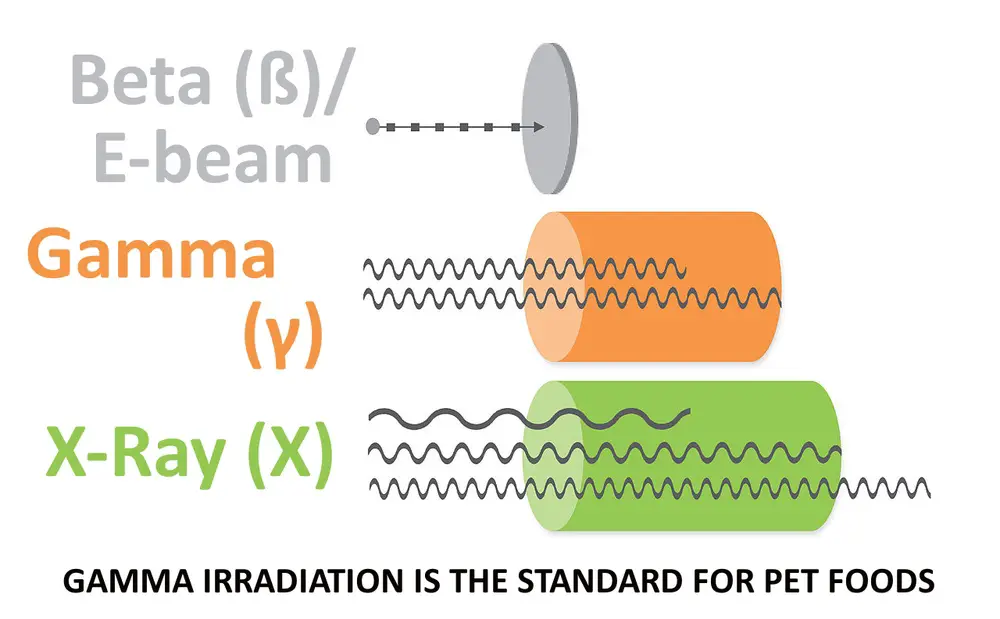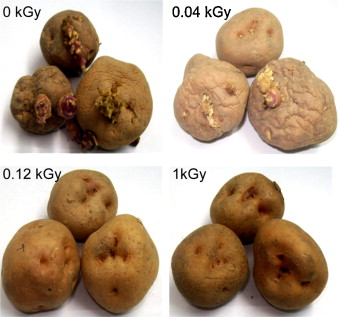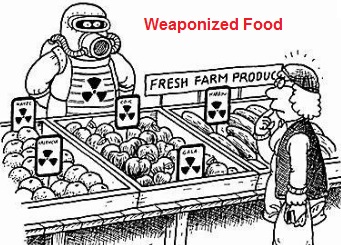Originally written by Jill Koh in April 2010.
Second review and minor revisions by Philip Button in July 2020.
History of food preservation can be traced back many, many decades ago, with various processing methods such as canning, pasteurisation, and flash freezing. Food irradiation is a newer method of food preservation which is increasingly employed by food manufacturers to complement existing technologies due to the number of beneficial effects on foods (“Food Irradiation,” 1994). The process calls for controlled exposure of foods to a source of ionising radiation energy under specific environmental conditions (usually gamma rays and electron beams – Figure 1) at adequate levels to produce the desired result, yet avoiding degradation of the product (“Food Irradiation,” 1994).
A unique advantage of irradiation is its strong penetrative power. Foods can be treated in their final packaging with only a slight increase in temperature, thus avoiding the possibility of recontamination (Henson, 1995). Furthermore, the three forms of radiation (radappertization, radicidation, and radurization, differentiated by radiation dosage) (Figure 2) were found to be effective in enhancing keeping quality of foods, and were quickly adapted by meat manufacturers to eliminate Trichinella spirallis in meat (Henson, 1995).
As shown above, the benefits of food irradiation to known causes is established- sterilization and control of pathogenic and spoilage bacteria in foods are the primary objectives; while delay of ripening and sprouting hindrance in fruits and vegetables enable these commodities to have a long shelf-life (“Food Irradiation,” 1994). It was reported that sprouting in root crops can be inhibited at low irradiation doses of 0.05-0.15 kGy (“Food Irradiation,” 1994) (Figure 3). In another study, the use of gamma ray irradiation up to 10 kGy on beef sausage patties reduced bacterial populations with no adverse effect on quality and sensory characteristics (Park, et al., 2010). These had led to a huge leap in quantity of irradiated foods with 405 000 ton produced globally (Kume, Furuta, Todoriki, Uenoyama, & Kobayashi, 2009).
As with all new food processes, food irradiation has generated criticism from health experts due to potential health risks and conflicting evidence on the effects and safety of irradiated foods (Diehl, 2002; Louria, 2000). Acceptance of irradiated foods is not uniform globally; with Japan and United States embracing the technology while progress in the European Union is slow (Diehl, 2002; Kume, et al., 2009). Moreover, the regulation of irradiated foods in different countries are not standardized, hence resulting in difficulty to assess the nutritional content and safety of irradiated food products (Diehl, 2002). However, as of 2010, food irradiation is approved in over 55 countries (Junqueira-Gonçalves et al., 2011), which is certainly promising for its widespread commercial use.
Public opinion on irradiated foods was considered positive during the growth of nuclear technology in 1950 (Diehl, 2002). However, the climate of consumer views changed with the progress of anti-nuclear movement and increased knowledge of health and nutrition (Figure 4). To counteract this phenomenon, a study group on High Dose Irradiation examined the results of safety studies on foods irradiated with doses higher than 10 kGy in 1997 (Diehl, 2002). It was concluded that few foods withstand doses above 10 kGy without sensory quality loss. Also, a study on animals fed with foods irradiated up to 70 kGy showed no adverse health effects. Thus, the study group concluded that foods irradiated to achieve intended technological purposes are both safe and nutritionally satisfactory (Diehl, 2002). In Australia, a study conducted found no significant changes in fatty acid compositions of Black Bream and Redfish after gamma-irradiation treatment of up to three times the recommended dosage, albeit vitamin E loss remained uncertain (Armstrong, Wyllie, & Leach, 1994).
Despite reassurance on non-toxicity and radioactivity in irradiated foods by governmental and health authorities, major concerns remain on the safety and nutritional adequacy of irradiated foods due to conflicting results and conclusions made by opposing parties (“Food Irradiation,” 1994) (Figure 5). Fears of carcinogenic food from irradiation that leads to DNA damage was suggested in a human study that found chromosomal breaks in malnourished children fed with irradiated wheat (Louria, 2000). The findings were consistent in another experiment when irradiated wheat was fed to monkeys and rats (Tritsch, 2000). In addition, irradiation was found to destroy some vitamins, such as loss of thiamin content in irradiated pork (Louria, 2000); and reduced level of vitamin E in irradiated rolled oats (“Food Irradiation,” 1994). Furthermore, it was reported by Tritsch (2000) that the number of bacteria increased exponentially during cold storage of irradiated fish fillet, implying division of all cells and progeny produced. Bacterial contamination of the fish fillets equaled that of non-irradiated fillets upon additional 14 days of storage. It was also suggested that the new population of bacteria are more radiation resistant than the original population. Lastly, the most radiation-resistant organism, Deinococcus radiourans was isolated from irradiated canned meat (Tritsch, 2000). These food scares has led to proposition by consumer groups the possibility of food irradiation employment to conceal bad manufacturing practices (Henson, 1995).
As demonstrated above, food irradiation remains a controversial issue with many barriers to overcome before gaining support from consumers and opposition parties for widespread use. To aid this process, (Louria, 2000) has proposed testing of irradiated foods by external parties with full disclosure of results placed on the label of the final product. Another issue to address is the lack of confidence in the process of scientific approval of food irradiation. Although irradiation of meat requires prior approval by Food and Drug Administration (FDA) and US Department of Agriculture’s Food Safety and Inspection Service (USDA/FSIS), consumers are still suspicious of the regulatory process itself due to loss of trust in both the government and administrative agencies (Henson, 1995). A good example is the UK government’s failure to warn consumers of the mycotoxin patulin in fruit juice which heightened consumer suspicions over the motives of food regulators (Henson, 1995). Another alternative is to market irradiated foods at selected consumer groups least sensitive to the technology. A striking observation was that irradiated foods sold very well to consumers who accept food irradiation (Henon, 1995; Henson, 1995). However, the most effective strategy in the long term would be to change consumer perception towards the technology. Existing attempts to promote the benefits of food irradiation have met with limited success due to the absence of solid evidence on the safety of irradiated foods (Henson, 1995). Consequently, it is important for authorities to promote food irradiation based on greater understanding of consumer concerns, social and cultural values to speed up adoption of the technology.
References:
Armstrong, S. G., Wyllie, S. G., & Leach, D. N. (1994). Effects of preservation by gamma-irradiation on the nutritional quality of Australian fish. [doi: DOI: 10.1016/0308-8146(94)90203-8]. Food Chemistry, 50(4), 351-357.
Diehl, J. F. (2002). Food irradiation–past, present and future. [doi: DOI: 10.1016/S0969-806X(01)00622-3]. Radiation Physics and Chemistry, 63(3-6), 211-215.
. Food Irradiation. (1994). In World Health Organisation, Geneva (Ed.), Safety and nutritional adequacy of irradiated food (pp. 4-11).
Henon, Y. M. (1995). Food irradiation in perspective. [doi: DOI: 10.1016/0969-806X(95)00235-P]. Radiation Physics and Chemistry, 46(4-6, Part 1), 647-651.
Henson, S. (1995). Demand-side constraints on the introduction of new food technologies: The case of food irradiation. [doi: DOI: 10.1016/0306-9192(95)00020-F]. Food Policy, 20(2), 111-127.
Junqueira-Gonçalves, M. P., Galotto, M. J., Valenzuela, X., Dinten, C. M., Aguirre, P., & Miltz, J. (2011). Perception and view of consumers on food irradiation and the Radura symbol. Radiation Physics and Chemistry, 80(1), 119-122.
Kume, T., Furuta, M., Todoriki, S., Uenoyama, N., & Kobayashi, Y. (2009). Status of food irradiation in the world. [doi: DOI: 10.1016/j.radphyschem.2008.09.009]. Radiation Physics and Chemistry, 78(3), 222-226.
Louria, D. B. (2000). Counterpoint on food irradiation. [doi: DOI: 10.1016/S1201-9712(00)90096-1]. International Journal of Infectious Diseases, 4(2), 67-69.
Mead, P. S., Slutsker, L., Dietz, V., McCaig, L. F., Bresee, J. S., Shapiro, C., et al. (1999). Food-Related Illness and Death in the United States. Emerging Infectious Diseases, 5(5), 607-625.
Park, J. G., Yoon, Y., Park, J. N., Han, I. J., Song, B. S., Kim, J. H., et al. (2010). Effects of gamma irradiation and electron beam irradiation on quality, sensory, and bacterial populations in beef sausage patties. [doi: DOI: 10.1016/j.meatsci.2010.01.014]. Meat Science, 85(2), 368-372.
Tritsch, G. L. (2000). Food irradiation. [doi: DOI: 10.1016/S0899-9007(00)00298-7]. Nutrition, 16(7-8), 698-701.






